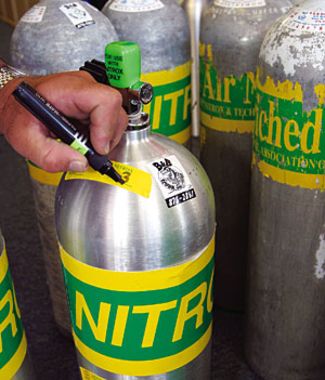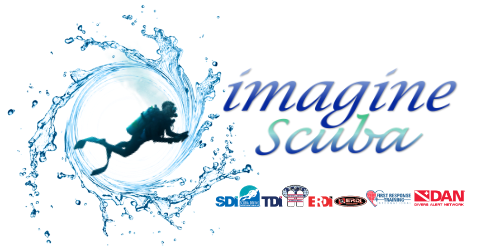There are many benefits to enriched air scuba diving, with the right training.

On today’s dive boats, you’d be hard-pressed not to see one or two of the telltale green and yellow tanks that announce the presence of nitrox, or oxygen-enriched air, which has been used in recreational diving for decades. Every major training agency has a nitrox training program in one form or another. But is it right for you? As with anything in diving, there are no absolutes when diving nitrox. Really, this gas is just like everything else in a diver’s bag of gear and knowledge—a tool that can be effective when used properly and dangerous when not. We’ll explore what nitrox is, what the risks are and what its practical uses are for the everyday diver.
What is nitrox?
In recreational diving terms, enriched air nitrox (EAN) refers to any nitrogen/oxygen gas mixture with an oxygen concentration higher than the 21 percent found in normal air–32 percent oxygen is the most common–and tanks filled with EAN are often clearly marked with a nitrox tank band and have the mix percentage written somewhere near the tank valve. It is this higher percentage of oxygen, and the proportionately lower percentage of nitrogen, that allows divers to lengthen no-decompression limits, shorten surface intervals and get an added safety buffer for decompression sickness in certain diving circumstances.
How does nitrox work?
As we’ve all learned from certification, when you dive, the water pressure causes nitrogen from the air you’re breathing to dissolve in your bloodstream. The higher the pressure, the more nitrogen will dissolve. After a certain concentration of nitrogen builds up, you must come back to the surface slowly in order to avoid either mandatory decompression stops or a case of decompression sickness (DCS). For example, based on the U.S. Navy dive tables, a diver on air at 100 feet reaches his or her no-decompression limit and must come up after 25 minutes. At 60 feet, the diver’s maximum time would be one hour. Nitrox changes the numbers. When you replace some of the nitrogen with extra oxygen, there’s less nitrogen available, which means it won’t dissolve as quickly, allowing a longer no-decompression limit. This concept is known as the equivalent air depth (EAD). For example, divers at 105 feet with 36 percent nitrox will dissolve nitrogen into their blood and tissues at the same rate as when breathing air at 80 feet. Therefore, the diver’s ordinary no-decompression limit of 20 minutes extends to 40 minutes — that’s double the bottom time.
What are the dangers of diving with nitrox?
This benefit does not come without some cost. Oxygen, while useful and essential to life, can become hazardous in high concentrations, potentially leading to acute oxygen toxicity, which has some very nasty effects that range from visual distortions to convulsions that can lead to drowning.
Any percentage of oxygen can cause toxicity at a high enough pressure. But diving on air, you would have to go very deep, in excess of 220 feet, to experience acute oxygen toxicity. The danger of nitrox is that it brings that possibility within recreational diving depths. There are two factors that divers using nitrox must consider regarding oxygen toxicity: One is the amount of exposure, or the pressure of oxygen in the lungs, and the second is the length of the exposure. Combined, these two factors are called the oxygen limit.
The pressure component of the oxygen limit is calculated using partial pressures, found by multiplying the percentage of oxygen in your tank by the atmospheres of pressure at your planned depth. For example, a diver breathing air (21 percent O2) at 132 feet (5 atm) is breathing a partial pressure of oxygen (PPO2) of 1.05 or the equivalent of breathing 105 percent oxygen at the surface. (5 atm x 0.21 = 1.05, 100 x 1.05 = 105 percent)
Technical divers will often dive to a partial pressure of oxygen of no more than 1.6 PPO2 for relatively short durations, generally no more than 45 minutes. After each exposure at this level, they need to off-gas a certain amount of oxygen before diving again. For this reason, most recreational training agencies use a more conservative rule with a maximum exposure of 1.4 or 1.45 PPO2. Most recreational dive schedules consist of no more than two dives in a half-day period of no more than one hour each, and at a PPO2 of 1.4, divers are allowed 150 minutes of bottom time–even if it is all completed on a single dive.
In order to avoid exceeding the safe depth limitations of their mix, nitrox divers are taught to use a table or complete a maximum operating depth (MOD) formula before each dive: (PPO2 / O2 percentage = MOD). Using this formula, a diver breathing EAN 35 will have a maximum operating depth of 99 feet, or 4 atm, when using the recreational limit of 1.4 PPO2: 1.4 / 0.35 = 4 atm, 33 feet x (4 atm – 1 atm–the one surrounding the earth) = 99 feet. Both the formula and the nitrox tables are easy with proper training, and an easily programmable nitrox dive computer can eliminate the need for calculation altogether.
What are the benefits of diving with nitrox?
The best application of nitrox is in the 50- to 100-foot range because no-decompression times for dives shallower than 50 feet are often so long that most recreational divers will empty their tank before they run out of dive time. In this deeper depth range, nitrox can have a huge effect on allowed bottom time, even doubling it under the right circumstances. For example, take EAN 36 to 100 feet and you can add 20 minutes to your 20-minute dive–a substantial benefit. Take that same mix to 60 feet, where the normal bottom time is 50 minutes, and your no-decompression limit extends to 130 minutes.
Many nitrox divers–especially those with certain risk factors for decompression sickness, such as previous DCS hits, physical injuries or older age–choose to use nitrox while following air tables to add a significant buffer zone to their no-decompression limits. With this application, divers breathing EAN 36 could do a dive to 60 feet for the maximum limit of the U.S. Navy air table and still be more than 60 minutes from reaching their no-decompression limit. This doesn’t guarantee 100 percent safety, but practical wisdom says the further you are from the no-decompression limit, the less likely you are to get bent.
Getting the right nitrox mix
The pre-mixes–usually about 32 percent–offered at most dive shops, make life simple. Just pick up the tank, check the mix and adjust your dive plan accordingly. But there is life beyond 32 percent. If you ask in advance, your dive shop will most likely blend a tank with whatever percentage you need for your dive, as long as it’s below the recreational limit of 40 percent. Custom mixes like this really do give you the best bang for the buck. For example, using EAN 32 at 70 feet only adds 10 minutes to your 50-minute bottom time. But using EAN 40 at 70 feet will double your bottom time to 100 minutes, definitely giving you more dive for your dollar without compromising your risk of DCS. Technical divers call this selecting the “best mix” for the dive and it is done by completing a simple formula: PPO2 limit/ATA (pressure at the maximum depth of the dive).
Equipment Concerns
The U.S. Navy and the National Oceanic and Atmospheric Administration (NOAA) say standard scuba equipment is perfectly safe for oxygen concentrations up to 40 percent. Since this is also the maximum recreational limit for nitrox diving, there has never been a single accident with recreational diving equipment used within recreational nitrox limits. (Note: Some manufacturers use a more conservative rule. If yours does, you should always follow the manufacturer’s recommendations.)
Contrary to popular belief, oxygen does not burn; however, it does enhance the flammability of everything that it contacts–the higher the concentration of oxygen, the hotter the flame and the more rapid the burn. For this reason, there is one equipment exception for divers who both own their own cylinders and get custom blends from partial pressure fill stations. Partial pressure blending–the most common method of making custom mixes–means pure oxygen is added to the tank first and then filtered or “clean” air is added second. When filling a tank with pure oxygen, there’s a risk of fire in improperly maintained cylinders because the valves normally used in scuba tanks contain seats, O-rings and lubricants that are incompatible with pure oxygen use. Additionally, normal air contains extremely small amounts of oil residues and hydrocarbons. These residues can build up in scuba tanks and valves. If all of these substances are not removed, they can provide fuel for flashing–very small fires that burn out rapidly–when exposed to high pressures and concentrations of oxygen. So, divers who have their own tanks filled with this method must have the cylinders cleaned for oxygen use, and these cylinders must be kept clean by only filling them with nitrox or cleaned air and by servicing them annually like any other tank.
Lingo and Equations
- Normoxic nitrox: Regular air, or cleaned air with 21 percent oxygen
- EAN: Any mix with more than 21 percent oxygen
- EAD: Equivalent Air Depth. The relationship between nitrogen absorbed at a particular depth breathing nitrox and the depth at which an equivalent absorption rate would occur breathing air.
- PPO2: Oxygen partial pressure, pressure in atmospheres x O2 percentage = PPO2
- MOD: Maximum operating depth, PPO2 / O2 percentage = MOD
- Best Mix: PPO2 limit/ATA (pressure at the maximum depth of the dive) = O2 percentage for the dive
By Michael Ange

